7th Century Virupaksha Temple Hampi
The Virupaksha Temple of Hampi, a UNESCO World Heritage Site, is not just a place of worship; it’s a testament to the vibrant history and artistry of the Vijayanagara Empire. Its towering gopurams, intricate carvings, and rich tapestry of stories unveil a fascinating journey through time.
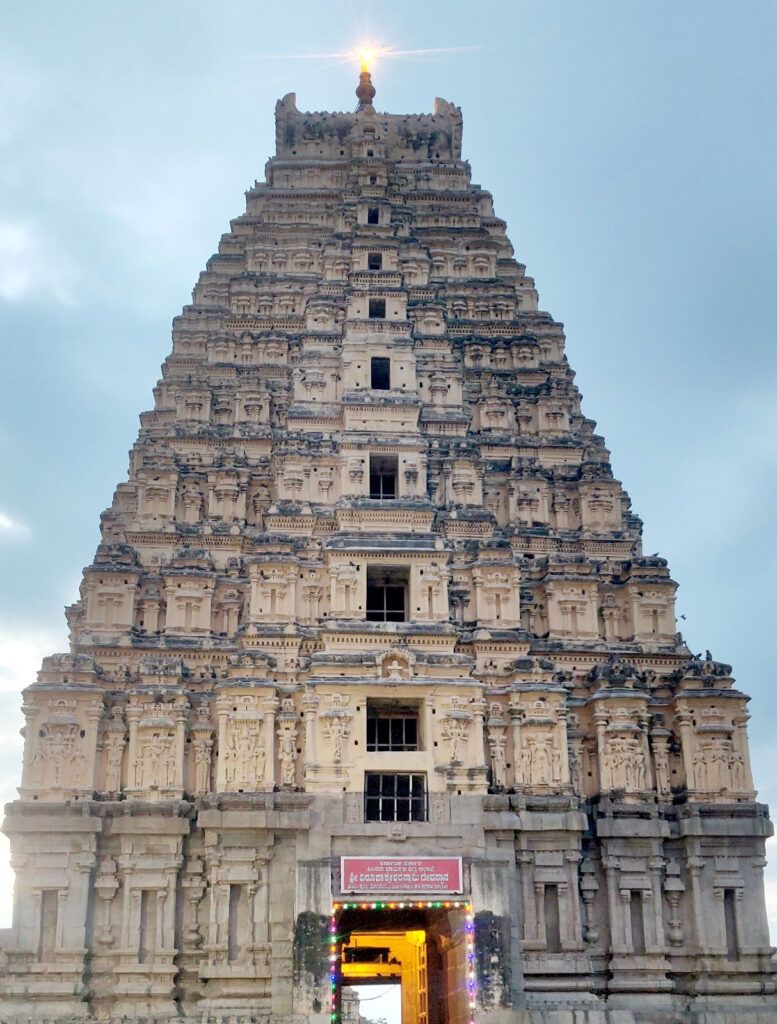
Contents
- 1 Virupaksha Temple History:
- 2 Legend of Virupaksha Temple Hampi:
- 3 Virupaksha Temple Architecture:
- 4 Significance of Virupaksha Temple Hampi:
- 5 Myths and Beliefs of Virupaksha Temple Hampi:
- 6 Virupaksha Temple Timing and Rituals:
- 7 Places to visit near Virupaksha Temple Hampi:
- 8 FAQ:
- 8.0.1 Where is Virupaksha Temple located?
- 8.0.2 What is Virupaksha Temple dedicated to?/ Which God is Virupaksha temple for?
- 8.0.3 When was Virupaksha Temple built?
- 8.0.4 What are the main features of Virupaksha Temple?
- 8.0.5 Why is Virupaksha Temple important?
- 8.0.6 What are the timings of Virupaksha Temple?
- 8.0.7 What is the entry fee for Virupaksha Temple?
- 8.0.8 What are the best ways to reach Virupaksha Temple?
- 8.0.9 What are some other things to see and do in Hampi?
- 8.0.10 What is the Virupaksha temple famous for?/ Why is Virupaksha famous?
- 8.0.11 What is the story of Lord Virupaksha?
- 9 How to reach Virupaksha Temple Hampi:
- 10 Google Maps:
Virupaksha Temple History:
Early Beginnings:
The temple’s history stretches back to the 7th century, long before the rise of the Vijayanagara Empire. It started as a humble shrine dedicated to Lord Shiva, known locally as Virupaksha or Pampapati, the consort of the river goddess Pampa. Inscriptions dating back to the 9th and 10th centuries confirm the temple’s existence even before the city of Hampi became a major center.
Vijayanagara Era:
During the reign of the Vijayanagara Empire (1336-1565), the Virupaksha Temple witnessed significant growth and embellishment. Lakkan Dandesha, a chieftain under the ruler Deva Raya II, played a crucial role in its expansion. The iconic nine-story eastern gopuram, towering 50 meters above the ground, was built during this period.
The Vijayanagara kings also added several halls, mandapas, and other structures to the temple complex. These additions showcase the architectural prowess of the era, characterized by intricate carvings, vibrant colors, and intricate detailing.
Surviving Destruction:
In 1565, the city of Hampi was ravaged by the Deccan Sultanates. While most of the city lay in ruins, the Virupaksha temple remained miraculously intact. This is attributed to its continued use as a place of worship by the local communities.
Even today, the Virupaksha Temple is an active Hindu pilgrimage site. The daily rituals and vibrant festivals offer a glimpse into the enduring traditions of the region.
Read More>> Enchanting Chidambaram Nataraja Temple: 5 Formless Akasha Lingam
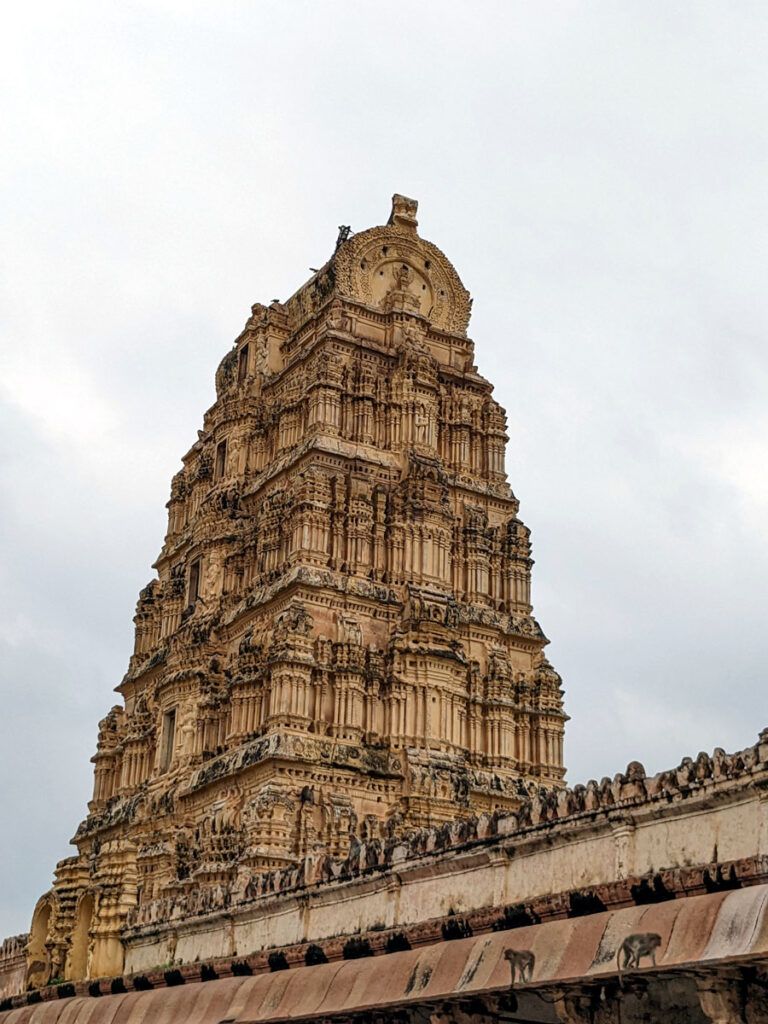
Legend of Virupaksha Temple Hampi:
The Birth of a Temple:
The earliest whispers of the Virupaksha Temple date back to the 7th-8th centuries CE. At that time, the site housed a shrine dedicated to the local goddess Pampa, who was associated with the life-giving Tungabhadra River. Later legends, however, would weave a more intricate narrative, one that linked Pampa to the mighty Shiva himself.
Pampa and Virupaksha:
One legend narrates the tale of Pampa, a beautiful and compassionate woman who lived by the banks of the Tungabhadra. She dedicated her life to worshipping Shiva, performing rigorous austerities and prayers. Her unwavering devotion ultimately moved Shiva, who appeared before her as the handsome Virupaksha. Pampa and Virupaksha were married, and their union gave birth to the Virupaksha Temple, which became a sacred place of worship for both Shiva and Pampa.
Lakkan Dandesha and the Rise of the Temple:
Another legend speaks of Lakkan Dandesha, a loyal chieftain under the Vijayanagara ruler Praudha Deva Raya. While hunting in the Tungabhadra forest, Lakkan Dandesha witnessed a vision of Virupaksha. The divine encounter inspired him to build a magnificent temple in the name of the god. With unwavering dedication and the support of the Vijayanagara empire, Lakkan Dandesha constructed the Virupaksha Temple, which became a symbol of the empire’s strength and devotion.
A Beacon of Endurance:
The Virupaksha Temple has stood witness to the rise and fall of empires. In 1565, the Vijayanagara empire was tragically destroyed by the Deccan Sultanates. Hampi, once a thriving city, became a desolate landscape of ruins. Yet, amidst the destruction, the Virupaksha Temple remained remarkably intact. This remarkable survival is attributed to the unwavering devotion of the local people who continued to worship there. The temple became a symbol of hope and resilience, a testament to the enduring power of faith.
Read more>> Srikalahasti Temple: 4th Air Vayu Lingam
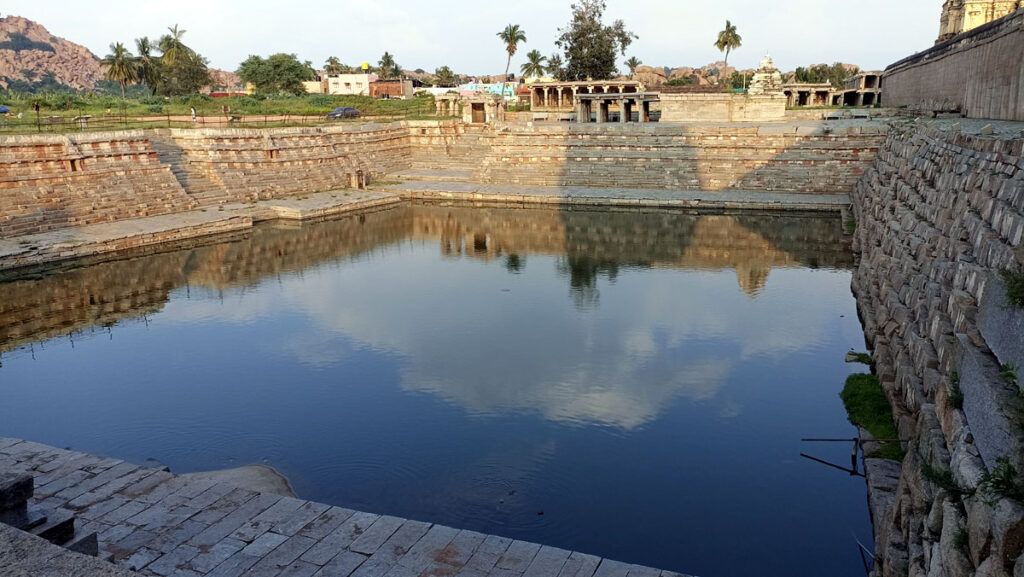
Virupaksha Temple Architecture:
- Raya Gopuram: The main entrance tower, known as the Raya Gopuram, is a towering structure that stands at the eastern entrance of the temple complex. It is a monumental gateway with intricate carvings and sculptures.
- Maha-Mandapa and Ranga-Mandapa: The temple has a large open hall called the Maha-Mandapa, which is a pillared hall used for various rituals and ceremonies. The Ranga-Mandapa is another hall within the complex, often used for cultural events and performances.
- Vimana (Main Shrine): The main sanctum, or Vimana, is dedicated to Lord Virupaksha. It is a compact structure with a pyramidal tower adorned with carvings and sculptures. The tower is a distinctive feature of Dravidian architecture.
- Kalyana Mandapa: This is a pavilion used for the ceremonial marriage of Lord Shiva and Goddess Parvati during annual festivals. The Kalyana Mandapa is known for its ornate pillars and detailed carvings depicting the divine wedding.
- Courtyards and Pillared Halls: The temple complex includes various courtyards and pillared halls, each serving specific purposes. These spaces were used for religious and cultural activities, gatherings, and as places for devotees to congregate.
- Hemakuta Hill Temples: The Virupaksha Temple is part of a larger complex that includes the Hemakuta Hill. Several smaller shrines and structures are spread across this hill, contributing to the overall architectural ensemble of the area.
- Carvings and Sculptures: The entire temple complex is adorned with intricate carvings and sculptures that depict various mythological stories, deities, and scenes from Hindu epics. The craftsmanship is a testament to the artistic excellence of the Vijayanagara Empire.
Read More>> 6th CE Sarangapani Temple Kumbakonam
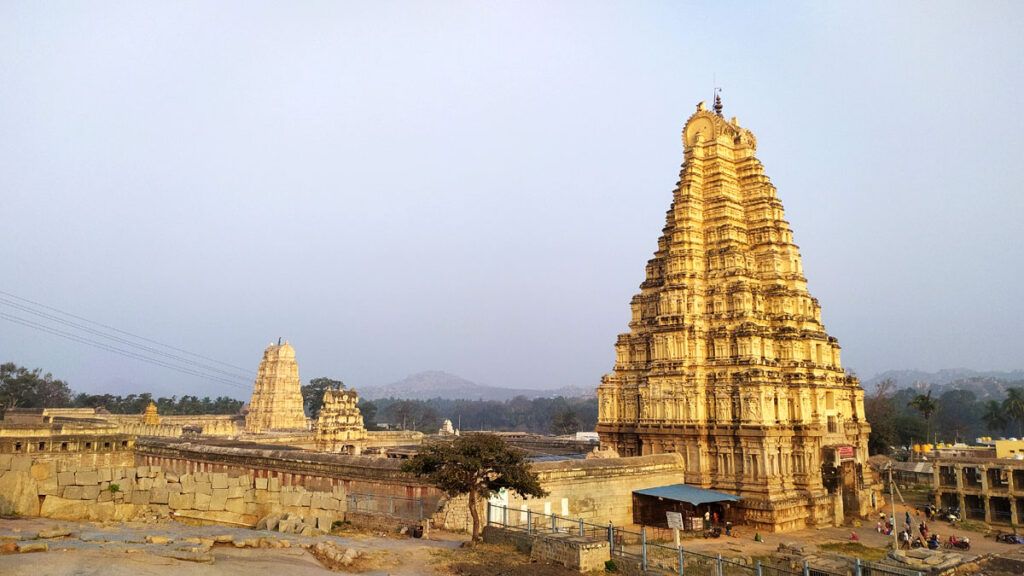
Significance of Virupaksha Temple Hampi:
Religious Significance:
- Dedicated to Lord Shiva: The temple is dedicated to Lord Shiva, known here as Virupaksha or Pampapathi, which translates to “Lord of the Pampa River.” The temple is considered one of the most sacred Shiva temples in South India.
- Pampapathi and Pampadevi: The temple’s association with Pampadevi, the local goddess representing the Tungabhadra River, adds to its spiritual importance. The temple complex houses a shrine dedicated to Pampadevi, signifying the union of Shiva and Shakti.
- Continuous Worship: Unlike many other temples in Hampi that were destroyed by invaders, the Virupaksha Temple has remained a continuous place of worship for over 13 centuries. This continuous devotion enhances its spiritual aura.
- Main Center of Pilgrimage: The temple is the main center of pilgrimage in Hampi. Hindus from all over India visit the temple for darshan of Lord Shiva and seek blessings.
Historical Significance:
- Living Monument of Vijayanagara Empire: The temple complex showcases the architectural brilliance of the Vijayanagara Empire. The intricate carvings, sculptures, and gopurams (gateway towers) reflect the artistic prowess of the era.
- Archaeological Treasure Trove: The temple complex houses several inscriptions, sculptures, and artifacts that provide valuable insights into the history and culture of the Vijayanagara Empire.
- UNESCO World Heritage Site: The Virupaksha Temple is part of the “Group of Monuments at Hampi,” designated as a UNESCO World Heritage Site in 1986. This recognition highlights the temple’s exceptional cultural and historical value.
Architectural Significance:
- Unique Architectural Style: The temple exhibits a blend of Dravidian and Chalukya architectural styles, showcasing the evolution of South Indian temple architecture.
- Elaborate Gopurams: The temple complex boasts three towering gopurams, each adorned with intricate sculptures and carvings. These gopurams serve as impressive gateways to the temple complex.
- Sculpture and Carvings: The temple walls and pillars are adorned with exquisite sculptures and carvings depicting various deities, mythological tales, and floral patterns. These carvings are a testament to the craftsmanship of the Vijayanagara period.
- Mandapas and Sanctums: The temple complex comprises several mandapas (halls) and sanctums, each serving a specific purpose in the rituals and ceremonies.
- Pampa Sarovar: The temple complex also houses the sacred Pampa Sarovar, a tank considered holy by Hindus. Pilgrims often take a dip in this tank before entering the temple.
Read More>> Adi Kumbeswara Temple Kumbakonam: Amazing Temple with 1000 Columns
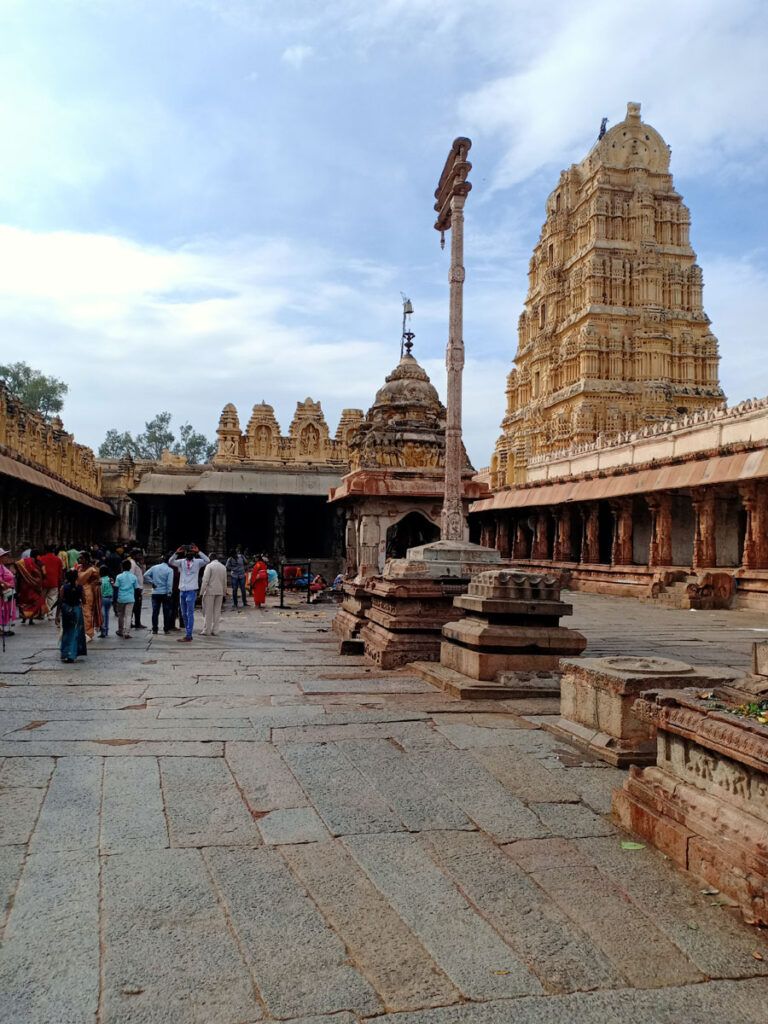
Myths and Beliefs of Virupaksha Temple Hampi:
The Virupaksha Temple in Hampi is steeped in mythology and legends, making it a site of immense religious significance. Here are some of the most prominent myths and beliefs associated with the temple:
1. The Marriage of Pampa and Shiva:
The most well-known myth surrounding the Virupaksha Temple is the story of Pampa, a local goddess, and her marriage to Lord Shiva. According to the legend, Pampa was a beautiful and devout woman who performed intense penance to win Shiva’s heart. Impressed by her devotion, Shiva appeared before her and married her. The Hemakuta Hill in Hampi is said to be the place where Shiva performed his own penance before marrying Pampa.
2. Virupaksha, the One with Oblique Eye:
The name “Virupaksha” literally translates to “the one with oblique eye,” referencing Lord Shiva’s third eye. This eye, which is said to possess immense destructive power, is usually closed. However, according to a myth, Shiva opened his third eye in anger while meditating on Hemakuta Hill. This caused a great earthquake and a powerful river to emerge from the ground, which is believed to be the Tungabhadra River that flows near the temple.
3. The Curse of the Sister Rocks:
Near the Pataleshwara Temple, there are two massive boulders that stand facing each other. Legend has it that these boulders were once human sisters who visited the area and remarked that it lacked any special significance. A Rishi, angered by their arrogance, cursed them to turn into stone. These rocks serve as a reminder to respect the sacredness of the place.
4. Badavalinga, the Shivling of the Poor:
One of the most intriguing sights within the temple complex is the Badavalinga, a massive Shivling measuring about 22 feet in height. According to legend, a poor woman discovered this Shivling while working and offered it with utmost devotion. Since then, it has come to be known as the “Shivling of the Poor” and is believed to fulfill the wishes of those who offer prayers and seek blessings.
5. The Upside-Down Shadow:
In a chamber located behind the Virupaksha Temple, there is a phenomenon related to the shadow of the main tower. During specific times of the year, the shadow of the tower appears to fall upside down, defying the laws of physics. This phenomenon is attributed to the divine powers of Lord Shiva and is considered an auspicious sign.
6. The Temple that Never Sleeps:
The Virupaksha Temple is unique in the sense that it has been continuously functioning as a place of worship for over 1,300 years. This unbroken tradition of devotion is attributed to the belief that the temple is never truly asleep. Even when the doors are closed, the divine presence of Lord Shiva is believed to be present within the sanctum sanctorum.
Read More>> Manasa Shakti Peeth Manasa Sarovar
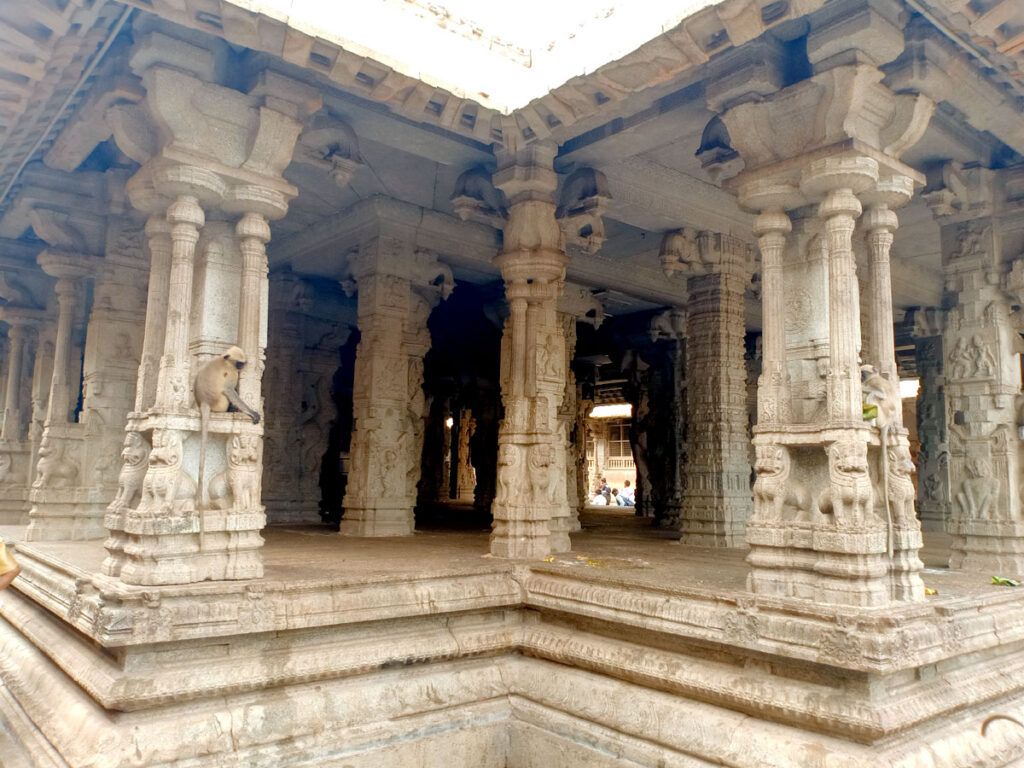
Virupaksha Temple Timing and Rituals:
Opening and Closing Timings:
- The Virupaksha Temple opens at 6:00 AM and closes at 9:00 PM daily.
- The Darshan (viewing) timings are as follows:
- Morning: 7:00 AM to 12:00 PM
- Evening: 5:00 PM to 8:30 PM
Special Timings:
- Poojas (rituals):
- Morning Pooja: 7:30 AM
- Evening Pooja: 6:30 PM
- Abhisheka (holy bath): 8:00 AM
- Harati (offering of light): 6:45 PM and 8:30 PM
Rituals:
- Nitya Pooja: Performed six times a day, offering various items to the deity.
- Abhisheka: A holy bath for the deity with milk, ghee, honey, panchamrut, and other sacred ingredients.
- Harati: Offering of light to the deity with camphor and ghee.
- Mahamangalarati: A grand offering of light performed on special occasions with hundreds of lamps.
- Deepotsava: Festival of lights celebrated during Karthika month with thousands of oil lamps illuminating the temple.
- Brahmotsava: The annual ten-day festival celebrated in February or March, with processions, music, dance, and cultural events.
Read More>> Sacred 12 Jyotirlingas in India: A Symbol of Eternal Spirit
Places to visit near Virupaksha Temple Hampi:
- Vittala Temple: Famous for its iconic stone chariot and musical pillars, Vittala Temple is a must-visit. The complex is known for its impressive architecture and intricate carvings.
- Hemakuta Hill Temples: Explore the cluster of temples on Hemakuta Hill, offering panoramic views of the surrounding landscape and a great spot to witness the sunrise or sunset.
- Achyutaraya Temple: This temple is dedicated to Lord Tiruvengalanatha, a form of Vishnu. It is known for its impressive architecture and is located near the Courtesan’s Street.
- Lotus Mahal: This unique structure in the Zenana Enclosure is an example of Indo-Islamic architecture and is characterized by its lotus-like domes.
- Elephant Stables: These grandiose domed structures once housed the royal elephants. The architectural style is a blend of Hindu and Islamic influences.
- Queen’s Bath: A royal bathing complex with a central pool and a veranda all around, the Queen’s Bath is an interesting example of Vijayanagara architecture.
- Hazara Rama Temple: This temple is well-known for its exquisite bas-reliefs depicting scenes from the Ramayana on its outer walls.
- Badavi Linga and Lakshmi Narasimha Statue: Visit the massive monolithic Badavi Linga and the Lakshmi Narasimha statue nearby. The latter is a giant monolithic carving of Lord Narasimha.
- Tungabhadra River: Take a boat ride or a coracle ride on the Tungabhadra River to enjoy the scenic beauty of the surrounding landscape.
- Anegundi: A quaint village across the river, Anegundi is considered one of the oldest inhabited places in India. It has historical sites, including the Anegundi Fort.
FAQ:
Where is Virupaksha Temple located?
Virupaksha Temple is located in Hampi, Karnataka, India. It is situated on the southern bank of the Tungabhadra River, about 350 kilometers from Bangalore.
What is Virupaksha Temple dedicated to?/ Which God is Virupaksha temple for?
Virupaksha Temple is dedicated to Lord Shiva, who is known here as Virupaksha or Pampapathi. He is the consort of the local goddess Pampadevi, who is associated with the Tungabhadra River.
When was Virupaksha Temple built?
The original temple was built in the 7th century, but it has been expanded and renovated several times over the centuries. The most significant renovations were carried out during the Vijayanagara Empire, which ruled Hampi from the 14th to the 16th centuries.
What are the main features of Virupaksha Temple?
The temple complex is surrounded by three gopuras, or towers. The largest gopura, the Virupaksha Gopura, is over 50 meters tall. The temple also houses a number of shrines, including shrines dedicated to Lord Shiva, Pampadevi, and other Hindu deities.
Why is Virupaksha Temple important?
Virupaksha Temple is one of the most important Hindu temples in India. It is a major pilgrimage destination for Hindus from all over the world. The temple is also a UNESCO World Heritage Site.
Here are some frequently asked questions about Virupaksha Temple:
What are the timings of Virupaksha Temple?
The temple is open from 6:00 AM to 8:00 PM.
What is the entry fee for Virupaksha Temple?
The entry fee for the temple is ₹10 for adults and ₹5 for children.
What are the best ways to reach Virupaksha Temple?
The nearest airport is at Bellary, which is about 100 kilometers away. Hampi can also be reached by train or bus.
What are some other things to see and do in Hampi?
Hampi is a UNESCO World Heritage Site with a number of other historical and archaeological sites. Some of the other popular tourist attractions in Hampi include the Royal Enclosure, the Lotus Mahal, and the Hampi Bazaar.
What is the Virupaksha temple famous for?/ Why is Virupaksha famous?
The Virupaksha Temple in Hampi is famous for:
- Being a major pilgrimage center for devotees of Lord Shiva.
- Housing a 50-meter tall gopura (tower) and other impressive architecture.
- Playing a central role in Hampi’s history and culture.
- Being a UNESCO World Heritage Site.
What is the story of Lord Virupaksha?
The story of Lord Virupaksha is a complex one with various interpretations and origins. Here are the two most common versions:
1. Virupaksha as Shiva:
- Virupaksha Temple, Hampi
- Shiva as Virupaksha, holding Trishul
This version depicts Virupaksha as another form of Lord Shiva, the god of destruction and transformation. “Virupaksha” translates to “the one with the oblique eye,” referencing Shiva’s third eye.
According to this legend:
- A demon named Pampa tormented the land, causing drought and misery.
- Goddess Pampadevi, the deity of the Tungabhadra River, prayed to Lord Shiva for help.
- Shiva, moved by her pleas, manifested as Virupaksha and vanquished the demon.
- To bring prosperity to the land, Virupaksha married Pampadevi and resided in Hampi.
- The Virupaksha Temple in Hampi was built to commemorate this victory and is considered one of the most important Shiva temples in India.
2. Virupaksha as a Naga chief:
- Birupaksha statue, Nepal
This version originates from Nepal and portrays Virupaksha as a powerful Naga chief, a serpent deity.
According to this legend:
- Virupaksha was the king of the Nagas, who are believed to guard treasures and possess immense power.
- He resided in a cave beneath the Pashupatinath Temple in Kathmandu.
- One day, a woman approached him for help, seeking protection from her enemies.
- Virupaksha, feeling compassion, agreed to help her.
- A battle ensued, and Virupaksha emerged victorious.
- However, the struggle caused the earth to tremble, burying Virupaksha partially.
- It is believed that when Virupaksha fully emerges from the ground, the world will end.
How to reach Virupaksha Temple Hampi:
By Train:
The nearest railway station to Hampi is Hospet Junction (HPT). Hampi does not have its own railway station. From Hospet Junction, you can hire a taxi, auto-rickshaw, or take a local bus to reach Hampi, which is approximately 13 kilometers away.
By Bus:
Hampi is well-connected by road. You can take a bus from major cities in Karnataka, such as Bangalore or Hubli, to reach Hospet. From Hospet, you can then take a local bus or a taxi to Hampi.
By Road (Self-Drive or Taxi):
If you’re driving, you can reach Hampi by road. The road network is well-maintained, and you can use navigation apps or maps to guide you. You can also hire a taxi from nearby cities or towns to reach Hampi.
Local Transportation in Hampi:
Once you reach Hampi, you can explore the town and visit Virupaksha Temple on foot or hire a bicycle. Auto-rickshaws and local buses are also available for short distances.
